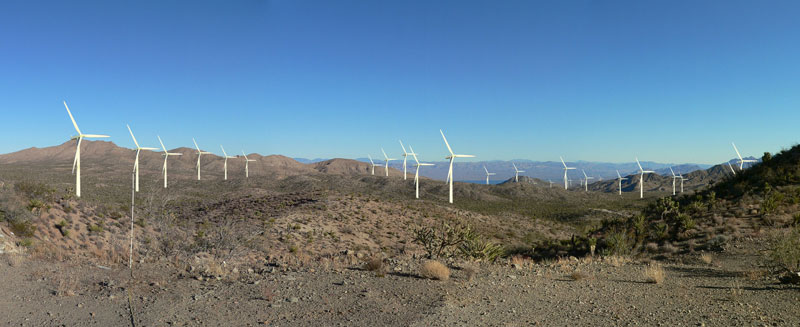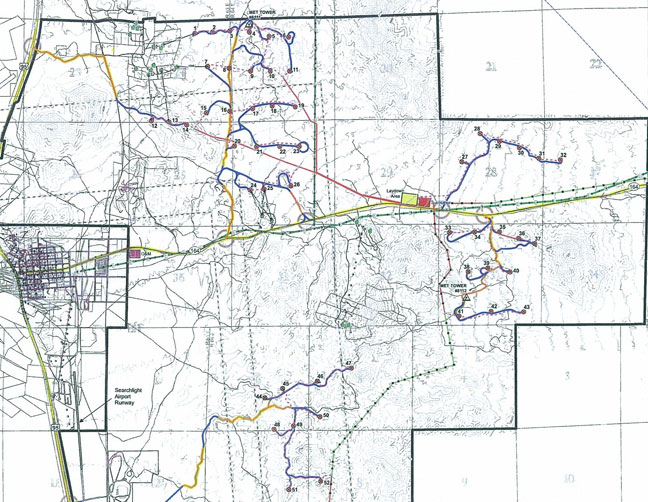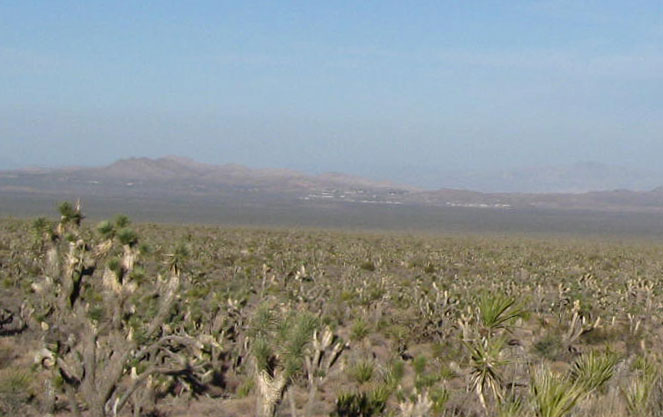Cancellation of Searchlight Wind Project Protects Tortoises and Golden Eagles
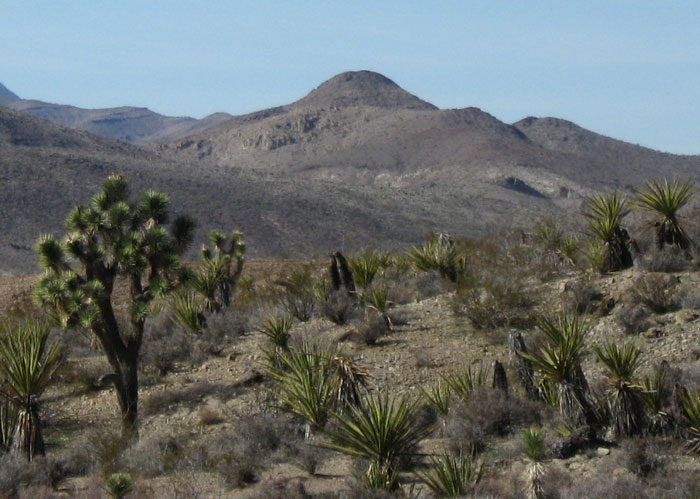
^Searchlight Hills, Nevada.
April 19, 2017 - Crews are now removing the wind testing meteorological (MET) towers for the Searchlight Wind Project which was proposed to be located on public lands in the Piute Valley about 50 miles south of Las Vegas, Nevada. According to the Bureau of Land Management (BLM) Las Vegas Field Office, the agency is now in the process of closing the application for the project, 18 months after a federal judge voided the federal approvals for the project because of the likely harm to desert tortoises and golden eagles.
In March 2013, the BLM issued a Record of Decision approving construction of the Searchlight Wind Energy Project. The project would have sited 87 industrial scale wind turbines, each 427 feet tall (about the height of the Palms Hotel), on the ridges and uplands next to the town of Searchlight, Nevada and bordering scenic Lake Mead National Recreation Area. The project would have marred the area’s scenic beauty, threatened the desert tortoise, killed golden eagles, desecrated the view of Spirit Mountain—sacred to Native American Tribes—impacted the historical mining district, and damaged the future tourism potential of the community. The project would have been sited on 9,300 acres of public lands managed by the Bureau of Land Management. The project site borders the Piute-Eldorado Area of Critical Environmental Concern, designated to protect the desert tortoise.
On October 30th, 2015, U.S. District Court Judge Miranda Du vacated the federal permits for construction of the Searchlight Wind Project in Southern Nevada. Judge Du found that environmental analyses prepared by the BLM and U.S. Fish & Wildlife Service (USFWS) inadequately evaluated the dangers that the industrial-scale wind project would pose to desert wildlife. She cited data missing from the agency surveys, inadequate assessment of potential threats to golden eagles, desert tortoises, and bats. The BLM claimed that only 3 golden eagle nests were within 10 miles of the proposed project, but it was later confirmed by the Nevada Division of Wildlife that the number of golden eagle nests was 28.
Kevin Emmerich, CoFounder of Basin and Range Watch, said, “We applaud the Bureau of Land Management for finally putting an end to this ill-sited wind project. There are clearly better alternatives for renewable energy utilizing rooftops and other locations in the built environment that would produce the same amount of megawatts. It is time for the BLM to manage this special location to protect the view-shed, wildlife, property values and cultural resources in a way that will bring tourist dollars to the region. This is no place for industrial scale energy.”
The BLM is considering another large-scale wind energy proposal in this region on over 35,000 acres to the west of the former Searchlight Wind Project. It would be called the Crescent Peak Wind Project and be located right next to the Mojave National Preserve and Castle Mountains National Monument. Basin and Range Watch has requested that the BLM designate the entire region a “Large-Scale Energy Free Zone” in their upcoming Southern Nevada Resource Management Plan.
“If a federal court ruled that there are too many potential harms to build an industrial-scale wind project near Searchlight, surely a far larger project like Crescent Peak with far more impacts should not be developed” said Laura Cunningham, Basin and Range Watch’s Executive Director. BLM expects to publish its Notice of Intent to prepare an Environmental Impact Statement for the Crescent Peak project later this year.
Judge Du’s October 30, 2015 order can be viewed here: http://www.basinandrangewatch.org/Searchlight-Order-Granting-Vacatu-10-30-15.pdf
The plaintiffs are represented by Dave Becker, an environmental lawyer from Portland, Oregon, and Jim Boyle of Holley, Driggs, Walch, Fine, Wray, Puzey & Thompson in Las Vegas.
Ninth Circuit Court Dismisses Second Appeal for Controversial Searchlight Wind Project
On October 26th, 2016, the US Ninth Circuit Court of Appeals dismissed an appeal by Apex Clean Energy against the October 30th, 2015, decision by Judge Miranda Du to void the Record of Decision by the Bureau of Land Management to approve the Searchlight Wind Project bordering the town of Searchlight, Nevada and close to National Park Service areas. The case was dismissed over jurisdictional issues.
The Searchlight Wind Energy Project would site 87 industrial scale wind turbines over 400 feet tall, about the height of the Palms Hotel, on the ridges and uplands next to Searchlight, Nevada and bordering scenic Lake Mead National Recreation Area. The project would negatively impact the scenery, threaten the desert tortoise, kill golden eagles, desecrate the view of Spirit Mountain—sacred to Native American Tribes—impact the historical mining district and damage the future tourism potential of the community.
On October 30th, 2015, U.S. District Court Judge Miranda Du vacated the federal permits for construction of the Searchlight Wind Project in Southern Nevada. Judge Du found that environmental analyses prepared by the Bureau of Land Management (BLM) and U.S. Fish & Wildlife Service (USFWS) inadequately evaluated the dangers that the industrial-scale wind project would pose to desert wildlife. She cited data missing from the agency surveys, inadequate assessment of potential threats to golden eagles, desert tortoises, and bats, The BLM claimed that only 3 golden eagle nests were within ten miles of the proposed project, but it was later confirmed by the Nevada Division of Wildlife that the number of golden eagle nests was 28.
“This was never a good choice for a wind project location” said Kevin Emmerich, Co-Founder of Basin and Range Watch. “An industrial scale wind energy project in this location would not only impact wildlife, but be visible for many miles at both day and night. The view and quality of life would be degraded for local residents. The project would be visible from 3 different National Park units and Sprit Mountain which is sacred to several Native American tribes in the region. Basin and Range Watch has asked the Bureau of Land Management to designate the entire area “Wind Energy Free”. This would protect wildlife, local residents and cultural values.”
The plaintiffs are Wayne and Judy Bundorf who have resided in the Las Vegas area since the 1960’s and have been employed in the engineering and construction industries. They have frequented the Searchlight area for decades enjoying the desert and Lake Mojave. Ellen Ross, another plaintiff, home owner and realtor has resided in Las Vegas since the 1970’s and frequently hikes and kayaks near Searchlight. Both families purchased desert properties in the early 2000’s for quiet desert landscapes within reasonable proximity to Las Vegas, which is 40 miles north. Basin and Range Watch is a party in this lawsuit, a local desert nonprofit which has made a concerted effort to protect the pristine Mojave Desert. Finally, plaintiff Mojave elder, Ron van Fleet, whose family personal history is embedded within the Searchlight Hills and Cottonwood Cove can attest to the unique history and cultural value of this desert. This pristine desert, with flora and fauna, is a key ingredient with the local people who live here, to be “in nature. ”
Searchlight Wind Project Granted Extension
August 14, 2015 - Las vegas NV - We attended a Nevada Public Utilties Commission meeting on the 12th, where the commission would hear comments and consider a request for a two-year extension by Apex Clean Energy to complete compliance items. We submitted comments that Apex (as Searchlight Wind LLC) has delayed start of constructiom for more than two and a half years since the Bureau of Land Management issued their Record of Decision, and the project was originally proposed seven years ago. We argued there has been significant new information since this time about impacts to golden eagles and desert tortoises which has not been considered. The commission voted, however, to extend the time allowed for Apex to start construction despite this.
Conservationists Ask for New Decision on the Searchlight Wind Project
March 12, 2015 - Last week, conservation groups, including Basin & Range Watch, asked the U.S. District Court in Reno, Nevada to order Secretary of the Interior Sally Jewell to take a fresh look at a controversial wind project in an area with the densest concentrations of protected golden eagles and one of the densest desert tortoise populations in Nevada. The latest motion asks Judge Miranda Du to vacate the Record of Decision and require the Secretary of the Interior to make a new decision whether to approve the project after the Bureau of Land Management and the U.S. Fish and Wildlife Service provide additional explanation for their wildlife analyses. More on >>Updates.
Judge Rules Against Interior and Apex
February 5, 2015 - Reno NV - In the case where Plaintiffs Judy Bundorf, Friends of Searchlight Desert and Mountains, Basin and Range Watch, Ellen Ross, and Ronald Van Fleet, Sr., allege that Defendants Secretary of the Interior Sally Jewell, Bureau of Land Management, and U.S. Fish and Wildlife Service violated several environmental statutes in approving a wind energy project in Southern Nevada. Searchlight Wind Energy, LLC , the project’s proponent, intervened as a defendant in November 2013. More on >>Updates.
Searchlight Wind Project Court Hearing: National Environmental Policy Act Weakened or Upheld?
Reno NV - A court hearing on November 24, 2014 at the Reno, Nevada, Federal Courthouse was attended by attorneys representing the Department of Interior and Apex Energy (as Searchlight Wind Energy, LLC), the project developer of the Searchlight Wind Energy Project which is proposed for desert land managed by the Bureau of Land Management in the Searchlight Hills of Clark County, NV. Judge Miranda Du set up a conference line for attendees in Las Vegas, and as plaintiffs, Basin & Range Watch listened in and took notes. More on >>Updates.
Basin & Range Watch Joins in Lawsuit
April 19, 2013 - Three Nevada residents, and the grassroot groups Basin & Range Watch and Friends of Searchlight Desert and Mountains are suing the Interior Department over its approval of the Searchlight Wind Energy Project, arguing the wind project would cause widespread damage to sensitive wildlife habitat.
Two groups -- Basin and Range Watch and Friends of Searchlight Desert and Mountains -- and three residents who live near what would become the Silver State's largest wind project filed the lawsuit in U.S. District Court for the District of Nevada in Las Vegas against former Interior Secretary Ken Salazar, the Bureau of Land Management, and the Fish and Wildlife Service. They claim the defendants failed to properly analyze the full impacts of the project on sensitive wildlife species and nearby residents.
Salazar signed a record of decision (ROD) last month approving the 200-megawatt Searchlight Wind project, which would be built on 18,949 acres of federal land about 60 miles southeast of Las Vegas. [The final Row-of-Way acreage is 9,300 acres.]
The 30-page complaint says that the environmental impact statement (EIS) "presents a one-sided and incomplete portrait of the proposed project and its likely adverse environmental impacts."
"The Project would pose significant adverse harm to a wide array of sensitive and protected species -- including desert tortoise, bighorn sheep, golden eagles, bald eagles, and resident and migratory birds and bats -- through direct, indirect, and cumulative impacts," the complaint says.
Instead of addressing these issues, "Salazar selectively relied upon his own agency's internal policies seeking to promote renewable energy on public lands, while disregarding other policies" that call for protecting sensitive species such as golden eagles.
The complaint argues that the Bureau of Land Management, US Fish and Wildlife Service and Salazar violated the National Environmental Policy Act, Endangered Species Act, and the Bald and Golden Eagle Protection Act when the project was approved.
The plaintiffs are asking U.S. District Judge Miranda Du to vacate and remand the final EIS, biological opinion and ROD back to the agencies, and to issue an injunction preventing BLM "from allowing construction to commence on the project through ground-clearing, site preparation, or other such actions until such time as Defendants have fully complied with the law."
The plaintiffs want BLM and FWS to redo the documents to consider the larger impacts not only to sensitive wildlife but also to the property values and quality of life of those living nearby, said Dave Becker, a Portland, Oregon-based lawyer representing the two groups and three residents.
The 428-foot-tall wind turbines would be visible from the Lake Mead National Recreation Area to the east, as well as the town of Searchlight, Nevada, where the light and noise from the spinning turbines could affect property values and quality of life -- none of which was considered by BLM in its EIS, Becker said.
"There are many species we are concerned about with this project," he said. "But one of the species we are most concerned about is the human species. This project is too close to where tortoises, eagles and people live."
The high desert country is no place for an industrial-scale wind farm like Searchlight Wind. Numerous species of birds use the nearby Colorado River as a migration corridor roughly 10 miles away from the proposed wind farm site. The area is habitat for golden eagles and bald eagles fish nearby in Lake Mojave.
Also at risk is the Mojave Desert tortoise. Fish and Wildlife has estimated the Searchlight Wind project area contains more than 388 acres of tortoise habitat. Bighorn sheep use the area as a winter migration route.
A large wind project would fragment the area with roads and trenching for underground cables. And there would be a lot of traffic on the roads during the 30-year life of the project. More roads mean more motorists, and that means the potential for more road kills.
Quality-of-life is also a major concern outlined in the lawsuit.
Of the three individuals named as plaintiffs in the lawsuit, Ronald Van Fleet Sr. is a member of the Fort Mojave tribe who uses the BLM lands that will be affected by the project for spiritual activities, including spiritual runs.
The two other plaintiffs -- Ellen Ross and Judy Bundorf -- live near the project site, and both are active volunteers working with Basin and Range Watch, as well as Friends of Searchlight Desert and Mountains.
Ross owns 17 acres of property as close as 800 feet from the project site. Bundorf owns 90 acres of property about 1.4 miles north of the wind farm project site.
In other places, wind turbines associated with the project would be constructed as close as 1,345 feet from residential properties, and the final EIS fails to disclose the full extent of properties that would be visually and aurally affected by the project.
Similarly, the final EIS fails to disclose or analyze effects of the project on recreation and tourism in the Searchlight area. Instead the EIS estimated that as many as 800 visitors might be drawn to view the turbines without ever evaluating whether the 300,000 visitors who annually come to the area for its scenic beauty and to use and enjoy the public lands and resources of the area will avoid the newly-industrialized area and seek recreation and tourism opportunities elsewhere.
See also ReWire by Chris Clarke >>here.
Three Giant Solar and Wind Projects Approved on Public Land
March 17, 2013 - On March 13 Secretary of Interior Ken Salazar announced the approval of McCoy Solar Energy Project (750 megawatts), Desert Harvest Solar Farm (150 MW), and Searchlight Wind Energy Project (200 MW). McCoy solar is a project by NextEra Energy, in Riverside County near Blythe CA, Desert Harvest is an EDF Renewable Energy (formerly enXco) project in Riverside County near Desert Center CA, and the Searchlight wind project is by Duke Energy in Clark County, NV. Secretary Salazar made the announcement in San Francisco with California Governor Edmund G. Brown, Jr.
Rally Against Wind Project
February 23, 2013 - See photos >>here.
Rally
February 11, 2013 - Join the rally in Searchlight, Nevada on February 23 to oppose the wind project.
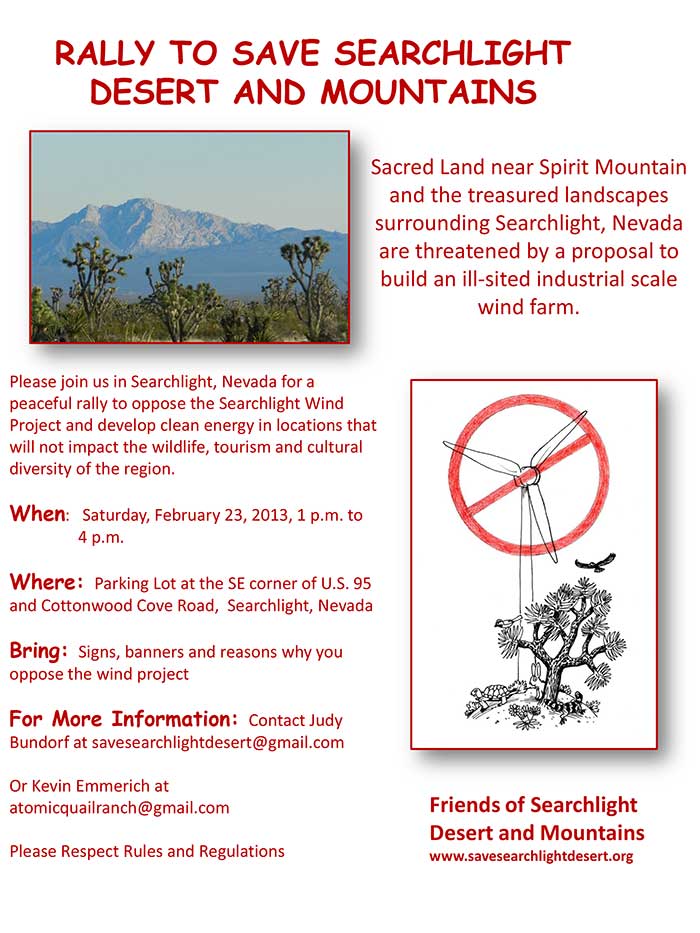
Final Environmental Impact Statement Released
December 14, 2012 - Searchlight Wind Energy Project: The Final Environmental Impact Statement has been released by the Bureau of Land Management. This will kill golden eagles, bald eagles and several other migratory Colorado River bird species. It will disturb a high density desert tortoise habitat and the view will be ruined from Lake Mead National Recreation Area, the Mojave National Preserve and several wilderness areas. >>here
Send Comments to Bureau of Land Management on the Final Environmental Impact Statement
April 14, 2012 >>here.
Public Meeting at Searchlight
March 10, 2012 - A public meeting was hosted to gather comments on the Draft Environmental Impact Statement for the Searchlight wind project by Bureau of Land Management on February 21, 2012. Three meetings were held, and we attended the meeting at Searchlight.
Currently the applicant Duke Energy is proposing to use Siemens 2.3 megawatt wind turbine generators, some of the largest on the market at 427 feet tall in total. The tower would reach 262 feet into the sky. There are alternatives with 96 and 87 turbines (originally in 2008 the number was around 167). One alternative has 9 less turbines by Cottonwood Cove.
The extent to which bats will be impacted by massive wind turbine generators is open to question. No studies we know of have been carried out in the Mojave Desert. We would recommend using the Precautionary Principle and carrying out detailed studies of bat migration and local breeding first, before any wind project is approved. But this is not how the government renewable energy project process works. Instead, "adaptive management" will be undertaken after the project is approved and in operation.
For bats, two years of mortality surveys will be done as the project operates. Thresholds for bat deaths will be held that could trigger cut-in speeds or feathering of the turbines. BLM is still working on the details of the post-construction mitigation plan. As a test of detectability of dead bats (they are easily missed by surveyors and often scavenged by coyotes, ravens, and other animals), BLM proposes that dead rats would be placed in the survey area and monitored to determine how many are removed by predators.
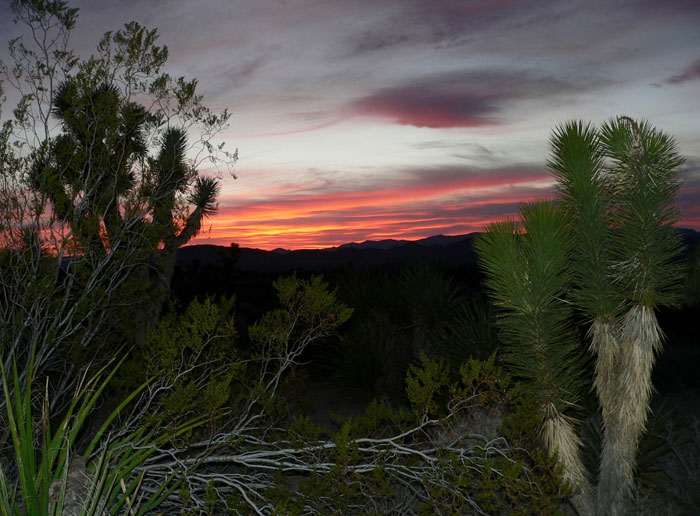
^Sunset in the Searchlight Hills, the hour when bats fly from their perches in pursuit of insects. (Photo by Wayne Bundorf)
An Avian Conservation Plan will be completed, including measures to mitigate for Golden eagles.
Desert tortoises are another issue, and BLM is considering temporary fencing to keep tortoises out of roads and pads during construction so they are not run over by trucks. Dense clusters of tortoises have been found on parts of the project area.
But beyond the threats to the rich biodiversity of the area, people matter too. Many local residents attended the meeting and voiced their concerns over the project so close to their homes. Issues of property values, health issues, and the quality of life in rural communities that would be negatively impacted by industrial energy projects.
See a summary of the meeting by reporter Tom Mitchell in the Ely Times here:
http://www.elynews.com/opinion/article_320b221e-6972-11e1-87bb-001871e3ce6c.html
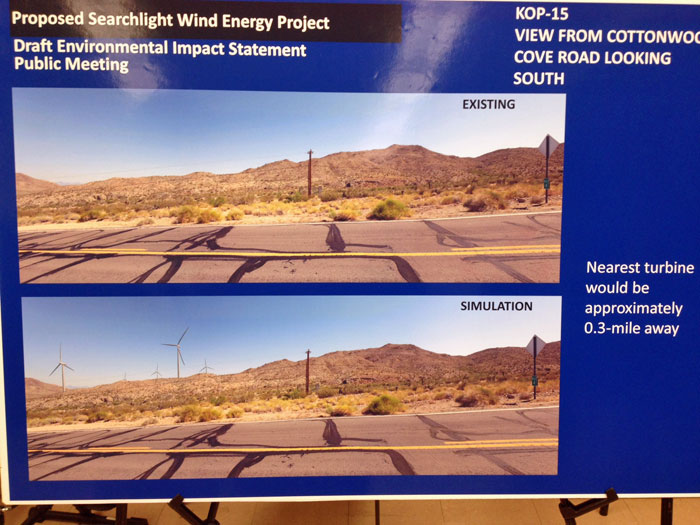
^One simulation of turbines as they might appear according to the applicant along Cottonwood Cove Road. We believe the turbines would gleam whiter.
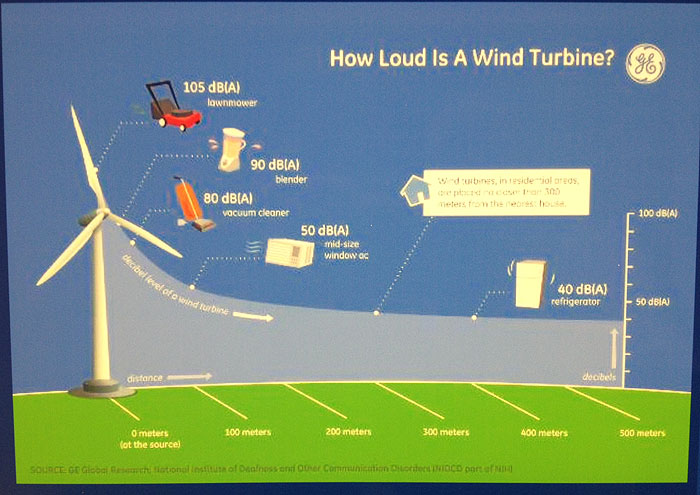
^Chart showing decibel levels of noise coming from a wind turbine generator. The recommendations by GE are to place turbines 300 meters from residences, although in other parts of the world the safe distance is 2 miles.

^BLM preferred alternative of 87 turbines.
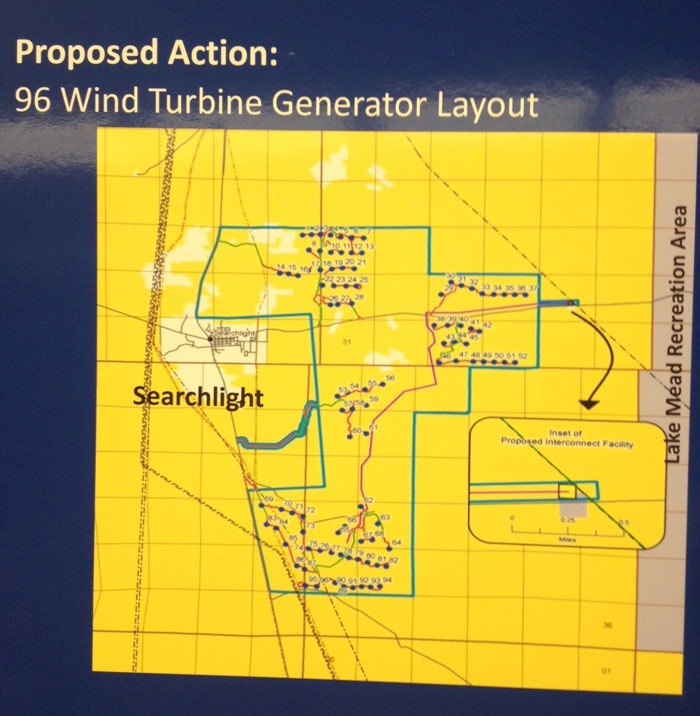
^Another alternative of 96 turbines.
Photos of Project Site
February 15, 2012 - These photos of the Joshua tree woodland that is proposed to be an industrial wind site were taken in the northen part of the project area recently. Very wide roads would have to be bulldozed through this pristine ecosystem.
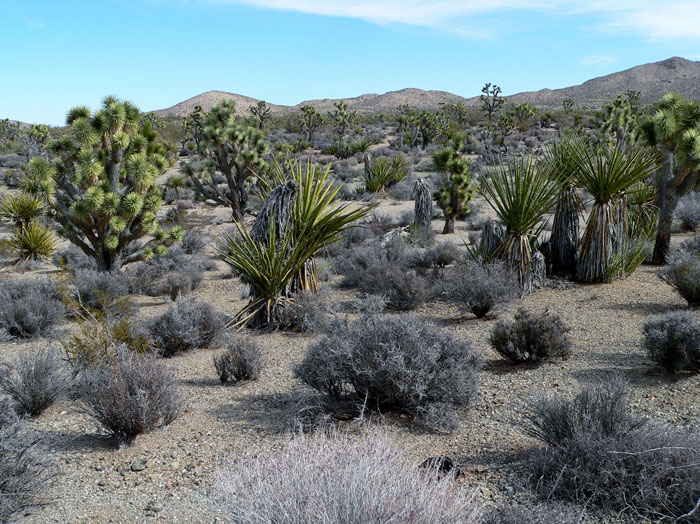
^Searchlight Hills, wind project area, with Joshua trees, Mojave yucca, and Blackbrush. (Photo by Wayne Bundorf)
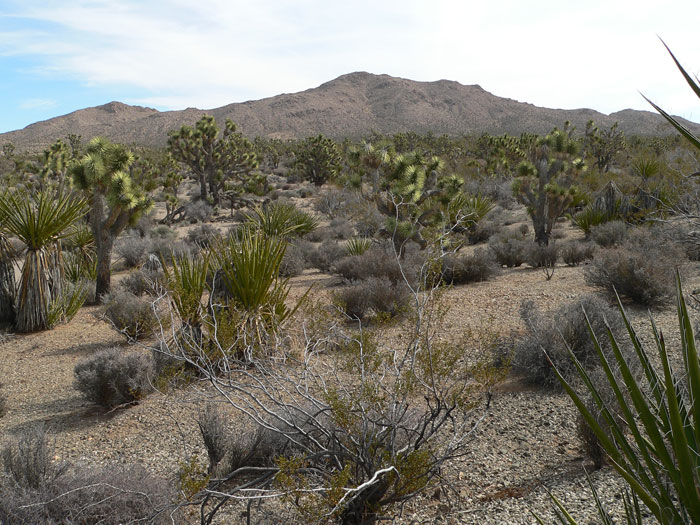
^Searchlight Hills, wind project area. (Photo by Wayne Bundorf)
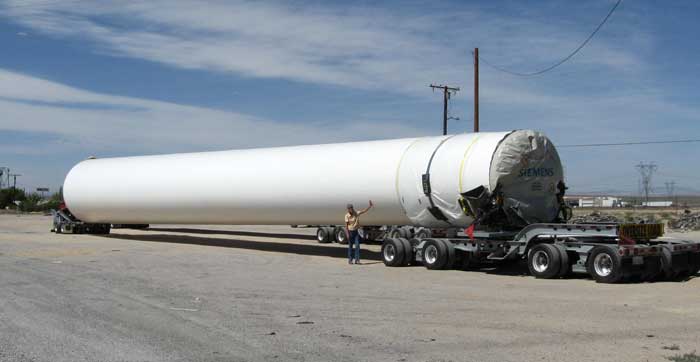
^Part of a wind turbine tower on an extra-long truck for transport. This truck will need to access the Searchlight Hills if the project is approved.
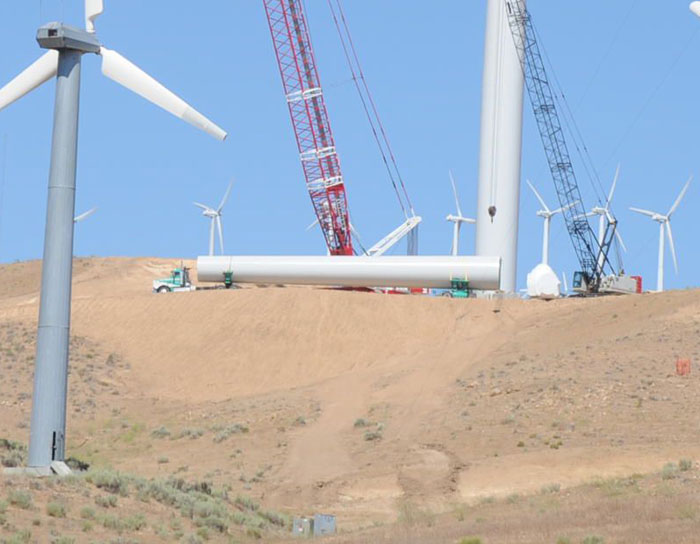
^New road graded in the Tehachapi Mountains of California for a wind project under construction. Note the size of the towers and the truck transporting a section to a newly-graded pad with cranes. A smaller wind turbine stands in the foreground but this design is no longer used. Larger designs are preferred today.
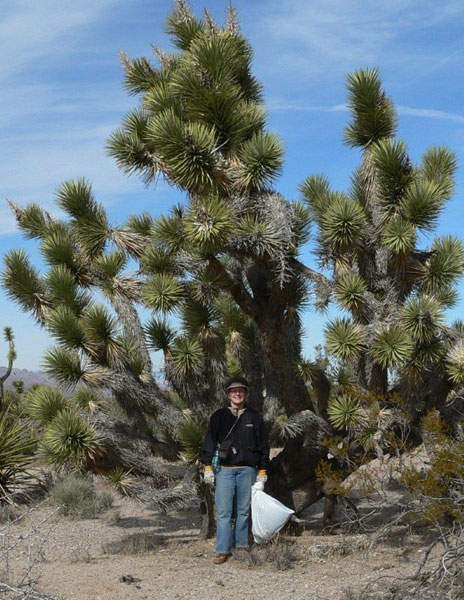
^Huge old-growth Joshua trees grow here, and many will be bulldozed if a wind project is approved.
Tortoise and Botanical Survey Reports
February 2, 2012 - These reports of surveys done on the Searchlight Wind Project site show dense desert tortoises inhabitaing the area. No rare plants were reported, however we believe many species would be found given thorough surveys during several years in appropriate rain seasons. The rare wildflower White-margined penstemon (Penstemon albomarginatus) is of potnetial for this area.
Desert Tortoise Inventory (5.02 MB PDF file)
Botanical Report December (5.6 MB PDF file)
After Delay, Draft EIS Published
January 20, 2012 - Bureau of Land Management published a Notice of Availability in the the Federal Register of the Searchlight Wind Draft Environmental Impact Statement saying that BLM prefers to approve this project. See the DEIS here: http://www.blm.gov/nv/st/en/fo/lvfo/blm_programs/energy/searchlight_wind_energy.html
“The proposed action analyzed in the Draft EIS is to approve the project in response to the applications received from SWE and Western. Three alternatives are analyzed in the Draft EIS--an 87 wind turbine layout, a 96 wind turbine alternative, and a no-action alternative. The 87 wind turbine alternative is the BLM's preferred alternative and has a smaller footprint than the 96 wind turbine alternative. The Draft EIS describes and analyzes the project's site-specific impacts on air quality, biological resources, cultural resources, environmental justice, geological resources, human health, and hazardous materials, lands and realty, noise, noxious weeds, paleontological resources, recreation, socioeconomic resources, transportation, visual resources and water resources.”
http://www.gpo.gov/fdsys/pkg/FR-2012-01-20/html/2012-940.htm
[Federal Register Volume 77, Number 13 (Friday, January 20, 2012)]
[Notices]
[Pages 2999-3000]
From the Federal Register Online via the Government Printing Office [www.gpo.gov]
[FR Doc No: 2012-940]
[[Page 2999]]
-----------------------------------------------------------------------
DEPARTMENT OF THE INTERIOR
Bureau of Land Management
[LLNVSO3100 L51010000 ER0000 LVRWF09F8740.241A; 12-08807; MO
4500027523; TAS: 14X5017]
Notice of Availability of the Draft Environmental Impact Statement and Notice of Segregation for the Searchlight Wind Energy Project, Clark County, NV
AGENCY: Bureau of Land Management, Interior.
ACTION: Notice of availability.
-----------------------------------------------------------------------
SUMMARY: In accordance with the National Environmental Policy Act of 1969, as amended, the Bureau of Land Management (BLM) has prepared a Draft Environmental Impact Statement (EIS) for the Searchlight Wind Energy Project and by this notice is announcing the opening of the comment period. Publication of this notice also serves to segregate the identified lands from appropriation under the public land laws for a
period of 2 years, including location under the Mining Law, but not the Mineral Leasing Act or the Materials Act, subject to valid existing rights.
DATES: To ensure comments will be considered, the BLM must receive written comments on the Searchlight Wind Energy Project Draft EIS within 90 days following the date the Environmental Protection Agency publishes this Notice of Availability in the Federal Register. The BLM will announce future meetings or hearings and any other public
involvement activities at least 15 days in advance through public notices, media releases, and/or mailings.
ADDRESSES: You may submit comments related to the Searchlight Wind Energy Project by any of the following methods:
Web site: http://www.blm.gov/nv/st/en/fo/lvfo/blm_programs/energy/searchlight_wind_energy.html
Email: BLM_NV_SNDO_SearchlightWindEnergyEIS@blm.gov.
Fax: (702) 515-5010, attention Gregory Helseth.
Mail: BLM Las Vegas Field Office, Attn: Gregory Helseth,
4701 North Torrey Pines Drive, Las Vegas, NV 89130-2301.
Copies of the Searchlight Wind Energy Project are available in the Las Vegas Field Office at the above address.
FOR FURTHER INFORMATION CONTACT: Gregory Helseth, Renewable Energy Project Manager, (702) 515-5173; 4701 North Torrey Pines Drive, Las Vegas, NV 89130-2301; email: BLM_NV_SNDO_SearchlightWindEnergyEIS@blm.gov. Persons who use a telecommunications device for the deaf (TDD) may call the Federal Information Relay
Service (FIRS) at 1-(800) 877-8339 to contact the above individual during normal business hours. The FIRS is available 24 hours a day, 7 days a week, to leave a message or question with the above individual. You will receive a reply during normal business hours.
SUPPLEMENTARY INFORMATION: Searchlight Wind Energy, LLC (SWE), a wholly owned subsidiary of Duke Energy, applied to the BLM for a right-of-way (ROW) grant on public lands to develop a 200-megawatt (MW) wind energy facility. The ROW application area encompasses approximately 18,789.71 acres of BLM-administered public lands adjacent to Searchlight, located approximately 60 miles southeast of Las Vegas, in Clark County, Nevada. The project is in conformance with the 1998 Las Vegas Resource Management Plan.
The proposed wind turbines would be up to 262-feet-tall from the ground to the hub with blades extending up to an additional 153 feet. The total height of each turbine would be up to 415 feet. In addition to the wind turbines, the proposed project would require the
construction of new access roads, two electrical substations, an overhead transmission line connecting the two substations, an electrical interconnection facility/switchyard owned and operated by Western Area Power Administration (Western), an operations and
maintenance building, and temporary and permanent laydown areas. Three permanent meteorological masts would remain on the site to measure the wind speed and direction across the site over the life of the project. SWE has requested to interconnect its proposed project to the electrical transmission grid via Western's Davis-Mead 230-kilovolt (kV)
transmission line. Western, a Federal agency, is participating in the EIS process as a cooperating agency and may use the EIS to support its decision to approve or deny SWE's interconnection request. Western has also submitted a ROW application to the BLM for construction and operation of the electrical interconnection facility/switchyard, which
is analyzed as part of this EIS.
The proposed action analyzed in the Draft EIS is to approve the project in response to the applications received from SWE and Western. Three alternatives are analyzed in the Draft EIS--an 87 wind turbine layout, a 96 wind turbine alternative, and a no-action alternative. The 87 wind turbine alternative is the BLM's preferred alternative and has a smaller footprint than the 96 wind turbine alternative. The Draft EIS describes and analyzes the project's site-specific impacts on air quality, biological resources, cultural resources, environmental justice, geological resources, human health, and hazardous materials,
lands and realty, noise, noxious weeds, paleontological resources, recreation, socioeconomic resources, transportation, visual resources and water resources.
A Notice of Intent was published in the Federal Register on December 16, 2008 (73 FR 76377). The BLM held three public scoping meetings in Searchlight, Laughlin, and Boulder City, Nevada, on January 27, 28, and 29, 2009, respectively. The formal scoping period ended on February 17, 2009. Sixty-six comment submissions were received, which
identified 384 issues. The issues are grouped into 14 main issue categories: Process, project alternatives, project description, project need, air quality, cultural, hazardous materials, land use, noise, socioeconomics, vegetation, visual, water, and cumulative impacts. Maps of the proposed project area and the alternatives analyzed in the Draft EIS are available at the Las Vegas Field Office. Please note that public comments and information submitted will be available for public review and disclosure at the above address during regular business hours (8 a.m. to 4 p.m.), Monday through Friday, except
holidays. Before including your address, phone number, email address, or other personal identifying information in your comment, you should be aware that your entire comment--including your personal identifying information--may be made publicly available at any time. While you can ask us in your comment to withhold your personal identifying
information from public review, we cannot guarantee that we will be able to do so.
In connection with its processing of SWE's and Western's application, the BLM is also segregating the public lands within the project application area for the project from appropriation under public land laws, including the Mineral Law of 1872, as amended, but
not the Mineral Leasing or the Material Sales Acts, for a period of 2 years from the date of publication of this notice. This is done under the authority contained in 43 CFR 2091.3-1(e) and 43 CFR 2804.25(e), and is subject to valid existing rights. The public lands contained
within this temporary segregation total approximately 18,789.71 acres and are described as follows:
[[Page 3000]]
Mount Diablo Meridian
T. 28 S., R. 63 E., Sec. 22, that portion of the E\1/2\SE\1/4\ lying east of the easterly right-of-way of S.R. 95 NVCC-020733;
Sec. 23, that portion lying east of the easterly right-of-way of S.R. 95 NVCC-020733, excepting Patent No. 27-72-0013, and patented mineral surveys;
Sec. 24, excepting patented mineral surveys;
Sec. 25, excepting patented mineral surveys;
Sec. 26, excepting patented mineral surveys;
Sec. 27, those portions of lots 1, 8, 9, 10, 14, and 15 lying east of the easterly right-of-way of S.R. 95 NVCC-020733.
T. 29 S., R. 63 E., Sec. 1;
Sec. 11, that portion lying east of airport leases NEV-065340 and N-81843;
Sec. 12, NE\1/4\, N\1/2\NW\1/4\, E\1/2\SW\1/4\, SW\1/4\SW\1/4\, and SE\1/4\;
Sec. 13;
Sec. 14, that portion lying east of the easterly right-of-way of S.R. 95 NVCC-020845, excepting airport lease NEV-065340;
Sec. 24, that portion lying east of the easterly right-of-way of S.R. 95 NVCC-020845;
Sec. 25, that portion lying east of the easterly right-of-way of S.R. 95 NVCC-020845.
T. 28 S., R. 64 E., Secs. 19 and 20;
Sec. 26, those portions of the N\1/2\NE\1/4\SW\1/4\, N\1/2\NW\1/4\SW\1/4\, and W\1/2\NW\1/4\NW\1/4\SE\1/4\, lying north of the northerly right-of-way of Cottonwood Cove Road;
Secs. 27 and 28;
Sec. 29, excepting patented mineral surveys;
Sec. 30, excepting patented mineral surveys;
Sec. 31, excepting patented mineral surveys;
Sec. 32, excepting patented mineral surveys;
Secs. 33 and 34. T. 29 S., R. 64 E., Sec. 4;
Sec. 5, excepting patented mineral surveys;
Secs. 6 to 8 inclusive, 17 to 20 inclusive, and 29 and 30.
The area described contains 18,789.71 acres, more or less, in Clark County, Nevada.
The BLM has determined that this temporary segregation is necessary to ensure the orderly administration of the public lands by maintaining the status quo while it processes SWE's and Western's ROW applications for the above described lands. The temporary segregation period will terminate and the lands will automatically reopen to appropriation
under the public land laws, including the Mining Law, if one of the following events occurs: (1) The BLM issues a decision granting, granting with modifications, or denying SWE's and Western's ROW authorization request; (2) Publication in the Federal Register of a notice terminating this segregation; or (3) No further administrative action occurs at the end of this segregation. Any segregation made under this authority is effective only for a period of up to 2 years.
Draft Environmental Impact Statement Due in December

^Wind turbine generators would scar the low hills in view of Spirit Mountain, on the right.
December 4, 2011 - With plenty of delays due to small project changes and new biological surveys, the first environmental review may be out in December 2011. The project is still on the table, and local residents are organizing against the large wind farm which would blade new roads into lush Mojave Desert yucca and Joshua tree areas. Members of the Chemehuevi and other local Tribes are concerned that their cultural heritage and traditions are being ignored. The area is close to Spirit Mountain along the Colorado River, an area held to be the origin spot for many Tribes. A "Spirit Run" is being planned for the Searchlight Hills to highlight the local cultural traditions and history of the area.
Seachlight Wind Project New Visualizations
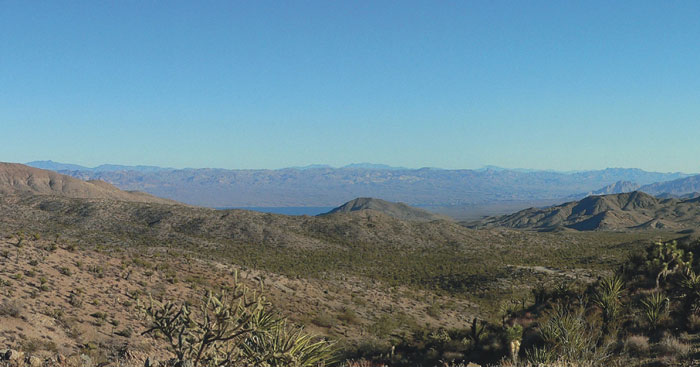
^Beautiful hills next to the town of Searchlight in southern Navada, with Lake Mohave (part of the Colorado River) in the background currently...
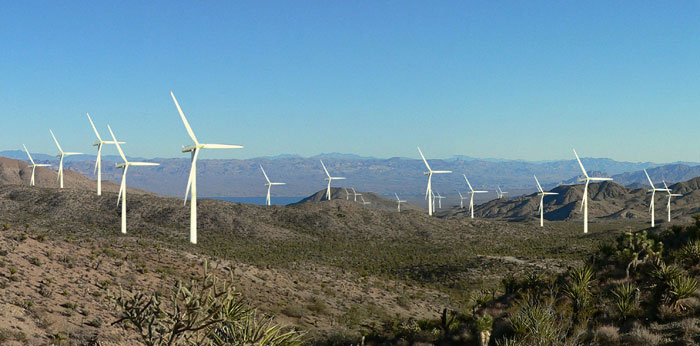
^And after proposed wind turbines are constructed. This visualization does not show all the new roads that would have to be graded into this pristine desert at access the turbine sites, fragmenting this Mojave Desert cactus-yucca-Joshua tree habitat.
February 6, 2011 - These photos represent “Before” and “After” showing the proposed locations for the 428-foot tall wind turbines planned by Duke Energy near Searchlight.
The photos were taken from a hilltop approximately 2.8 miles northeast of the intersection of U.S. 95 and State Route 164. The “before” photo shows thousands of acres of untouched ancient Joshua trees, Mojave Yuccas, Cholla, and creosote bushes, and beautiful views of Lake Mohave.
The “After” photo simulates the numbers of turbines, their location according to USGS topographic maps, and Duke Energy’s Site Layout Map dated November 10, 2009. This photo shows approximately 30 of the 87 turbines planned by Duke for the Searchlight area, and is accurate with respect to the relative height and distance from the site where the photo was taken.
There will be turbines on both sides of the road from Searchlight to Cottonwood Cove on Lake Mohave.
Three more wind farms are planned for the region, so four wind farms would be visible from the vantage point northeast of Searchlight, Nevada.
What the simulation does not show is the hundreds of acres of destruction necessary to grade wide, compacted access roads to each turbine, and the large areas cleared and leveled for each turbine, which may be anywhere from two to five acres for each construction site.
This area is frequented by Golden Eagles, Harris’s Hawks, Cooper’s Hawks, Red-Tailed Hawks, and Turkey Vultures. Many varieties of birds migrate through this area, as well as nest there. Twenty-one of the 23 species of bats found in Nevada have been documented in the Southern Nevada area.
The area is a migration route for the Desert Bighorn Sheep, and home to desert tortoise, many species of lizards, and desert rodents.
Power generated by the turbines will go to California.
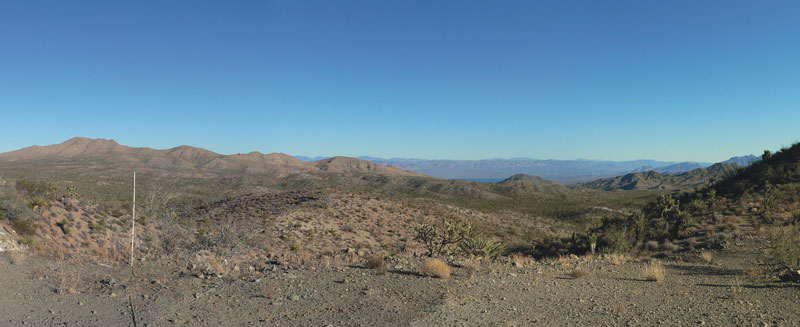
^Before...
^After.
Searchlight Wildlife Report
September 17, 2010 - Searchlight, Nevada -
^A group of turkey vultures perching on a communications tower in Searchlight. This area seems to be a migration corridor for the birds, and placing 400-foot tall wind turbines here may result in mortality. This tower is on the mountain just north of the Nugget, and is the tallest man-made structure around, but of course doesn’t move. The vultures migrate south in the winter, but residents tell us they never driven down Cottonwood Cove Road in the summer without seeing some. The most recent turbine map has approximately 30 turbines in the area where the vultures are seen circling daily. There are at least 11 birds on the tower, and several more were circling nearby.
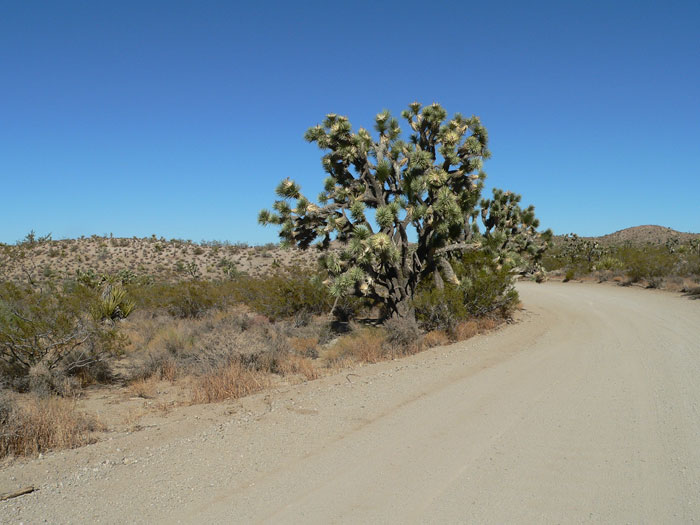
^These other three photos were taken along Oregon Trails Road north of Searchlight and a proposed access road to some of the turbines. This road is approximately 20 feet wide and has large numbers of Joshua Trees and creosote bushes on both sides. The plans are to improve this road and widen it to 36 feet, so trees on both sides will need to be “mitigated.”

^Large Joshua trees along a proposed access road to the Searchlight Wind Project will have to be dug up and mpved.
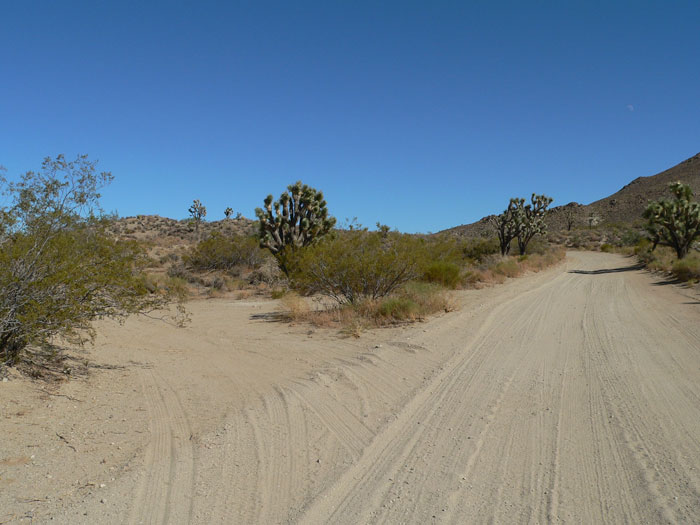
In addition, residents driving the area this week and studying the map, realized that approximately one-half to one mile of the road to be improved is shown following the alignment of the Gas Line Road. According to the folks who live near there, the gas line is buried only about 18 to 24 inches deep. It appears to be very near the surface, with a berm of earthwork covering it in some areas, because of the hard rock. It also follows the elevations of the terrain, and doesn’t appear to be buried at any great depth at all. This is one of the main gas lines that serves the Las Vegas Valley. Residents are concerned over equipment and grading creating a potential gas line rupture. The recent explosion and deaths at the San Bruno, California, PG&E natural gas pipeline come to mind.
Some of the turbine construction south of Searchlight may also be on or near the same gas line, or another gas line. Apparently there are several major gas transmission lines through the area. The gas is apparently coming from New Mexico, and the lines cross the Colorado River near Needles and then pretty much follow the alignment of Highway 95 to the Las Vegas Valley area.

^Truck carrying a wide load of one section of a Siemens turbine tower. These trucks will have to navigate the small winding dirt roads going up into the Searcjlight Hills.
Clark County Commission Votes
August 18, 2010 - Las Vegas, Nevada - The Clark County Board of Commissioners voted in favor of changing zoning to allow Duke Energy's Searchlight Wind Project.
Ignoring protests from residents and recreationists that the view will be impacted for miles and even be visible from Mojave National Preserve, the Commissioners listened somewhat impatiently to public comments. Tour guides explained that tourists do not come to kayak in Lake Mojave to see 400-foot turbines, but to get away from the city and industry. Local residents came to the meeting to explain their love the wildlife, and scenic views, and cultural sites. The Chemehuevi Tribe is worried about cultural viewscapes next to Spirit Mountain becoming impacted. Duke brought in a lawyer, former Nevada Senator Richard Bryan, to "rebut" opposing public comments in front of the Commission.
Commissioner Rory Reid, son of Senator Harry Reid (D-NV), walked out before the Searchlight Wind Project came up for discussion, yet later voted for it. He is running for Governor, and his father has a residence in the town of Searchlight. Rory Reid had a conflict of interest, as he has an interest in the same law firm as Bryan.
Wind Project Delayed
August 12, 2010 - Bureau of Land Management southern Nevada Renewable Energy Coordination Office manager Greg Helseth told us on August 10 that the Searchlight Wind Project has been delayed because of lack of biological reports from the applicant, Duke Energy.
Further complicating the project, a new power line upgrade and expansion south through the El Dorado-Piute Critical habitat is needed. Because desert tortoises are Federally Threatened, protocol-level surveys must be undertaken during certain seasons, and this has also caused delays. One percent of tortoise Recovery Units are allowed to be developed.
The Draft Environmental Impact Statement may be out in November 2010.
Under recent guidelines of the Bald and Golden Eagle Protection Act, helicopter surveys were undertaken around the Searchlight hills and "no raptors" were found. Any nest within 10 miles of the project boundary would need special management consideration and could delay a project.
On other news, NV Energy wants to build another wind farm north of Searchlight, according to BLM.
Heated Town Meeting
August 10, 2010 - About 60 Searchlight residents came to protest the large 230-megawatt wind farm slated for the hills and slopes around their town. Comments were about 10 to 1 against the project. Commissioner Steve Sisolak, who represents the small historic mining community on the county panel, called the meeting at the town community center to listen to comments from residents before the commission votes on special use permits for the project August 18. County planning staff recommended approval, and Sisolak said the commission usually accepts staff recommendations on land uses. Sisolak stated he received a call from Senator Harry Reid asking about the project. Sisolak also read a letter from Reid from 2001, where Reid objected to a gas-fired power plant proposal in the area.
Duke Energy needs the county permits and approval from the Bureau of Land Management for use of 9,396 acres, before it can erect 87 wind turbines (down from 161) that reach 428 feet from their base to the highest point of their blades. The closest turbine would be 2.5 miles from the town center, but still too close to the edge of town. Electricity would be sold to NV Energy, but also to California.
Many residents commented on how the wind farm was too close to town, how scarce water resources would be used up for making the large cement foundations needed by the giant turbines, how ancient Joshua trees would be torn up, the scenery affected, and how the small Searchlight airport would be prevented from growing by the tall turbines proposed near it.
Residents are concerned about the 38 miles x 36-foot wide roads equaling approximately 175 acres of compacted roadways. 28 miles of new roads would be constructed, as well as well as 18 miles of new overhead powerlines of 34.5 kV or more. Duke showed wind farm simulations, but the views were distant: from Railroad pass 30 miles from Searchlight, and across Lake Mohave in Arizona, not a very accurate representation of what the people ½ mile to 1-1/2 miles from the turbines will see.
The Clark County Planning board moved to waive certain county zoning standards: 35 feet is the current standard for height of structures, and the county would allow 428-foot wind turbines instead (a 1,123% increase). Also, noise levels would be allowed to increase from 43 decibels to 51.
Despite this increased noise, traffic, huge visual impacts, and impacts to natural resources in the area, the Board of County Commissioners decided to grant Duke five waivers, and claimed the wind farm would have no "undue adverse effects of adjacent properties, character of the area, or traffic conditions." In 2007 the Board had passed an "Eco-County Initiative Resolution to address the quality of life in Clark County through sustainability." "Green technologies" such as wind are considered sustainable, but impacts to property values are not considered. The Board assures residents that at no time turbines will be located within a quarter mile of houses.
Duke promised to give up to $275,000 to Searchlight for improvements to its community center, $3,000 yearly for math and science education at Harry Reid Elementary and, if possible, move a historic mining press to the town museum.
A banner at the meeting room at the Community Center read “This Place Matters.”
(From interviews with residents, Board of County Commissioners planning sheet dated July 21, 2010, and story in the Las Vegas Review-Journal.)
Duke Calls Wind a "Niche" Resource
July 19, 2010 - Utility regulators and executives should view renewables as "niche" sources of electricity rather than as a reliable solution to the nation's future energy needs, a Duke Energy Corporation executive told participants at the National Association of Regulatory Utility Commissioners meeting in Sacramento, California.
"Wind and solar resources provide a valuable niche role, but they are not the solution," Jim Turner, group executive of Duke Energy and president and COO of its U.S. franchised electric and gas business, said July 19. "I think we need to honestly acknowledge that as we think about the investments that we're going to be making" in the coming decades to repower America, he said, adding, "You've got to have your nuclear plants and your coal plants and your gas plants on the front lines."
Regulators and utilities need to strive to honor the balance between affordable, reliable and clean electricity generation, Turner said, commenting, "It doesn't matter how clean it is if it's not affordable or reliable."
From SNL News (subscription only), see www.windaction.org.
Latest Wind Turbine Map
July 14, 2010 - Searchlight, Nevada - The positions of some turbines have changed, and now each is assigned a number.
^Detail of map showing the town of Searchlight on the left, wind turbines on the right. Whole map >>here- 10.58 MB PDF.
Wind Turbines Kill Eagles
From East County Magazine - By Jim Wiegand, wildlife biologist.
April 17, 2010 (San Diego’s East County) -- The controversy surrounding wind farms in America has been brewing for over 25 years. The debate centers around the use of the deadly propeller style wind turbines and the large death toll to what are supposedly protected species. One of these species, the federally protected golden eagle, has been at the forefront of this debate from the beginning.
This is for good reason, because at Altamont Pass California, 50-75 golden eagles have been killed each year in the blades of the prop wind turbine. This killing has been taking place for over 25 years. Dr. Shawn Smallwood the foremost expert of bird mortality at the Altamont Pass wind farm estimates that 2300 golden eagles have been killed by the spinning turbine blades.
Along with the golden eagle, many thousands of other birds of prey have been slaughtered there as well from this source of green energy. As far as wind farms go, the history of Altamont pass is not an exception, it just happens to be the most scrutinized wind farm in the world. A cloak of secrecy now envelopes most other American wind farms. Despite this slaughter of raptors, corporate heads have been steamrolling ahead with wind farm expansion. Hundreds of thousands of prop wind turbines are now planned for America. One of the biggest regions for the harvest of wind energy is planned for the Western United States. Today Planning Departments all over the west are being faced with the choice of having wind power in their communities. In order to obtain the proper permits, Federal and State laws require an analysis of the environmental impacts so communities can make the right choice. My research into the wind industry has uncovered a very disturbing trend in their method of disclosing environmental impacts. What I have found is that the wind Industry in American routinely uses false or incomplete Environmental Impact Reports(EIR's) to white-wash the detrimental impacts of the prop wind turbine. Read more>>.
Can't find the data?
April 26, 2010 - On March 24th, 2010, Basin and Range Watch filed a Freedom of Information Act Request to the Las Vegas Bureau of Land Management Field Office regarding the biological resources reports concerning studies conducted by Duke Energy's contractor biologists. We wanted to see any survey reports on rare plants, desert tortoise, avian studies as well as all biological reports. As it turns out, BLM "conducted a thorough search and could find no responsive documents". It is our understanding that the Draft Environmental Impact Statement is being released in May. So if the BLM is writing an EIS, why is it that they have no data to base their biological resource information on? How about that Fast Tracking!
Revised Map, Updates
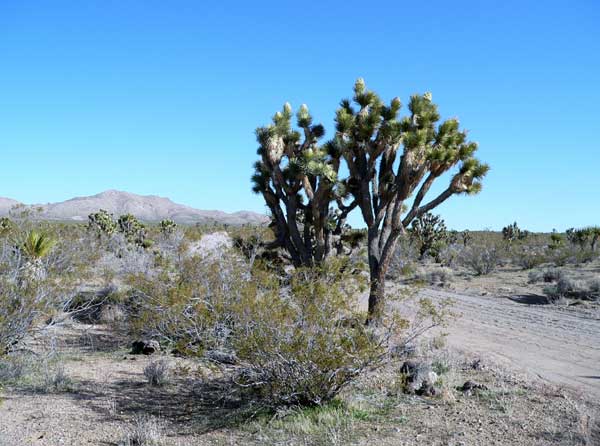
^Residents of the town of Searchlight took this photo along Grandpa's Road on March 14, 2010. The skyline to the right of the flowering Joshua trees is slated for wind turbines.
We visited the Las Vegas office of the Bureau of Land Management back in December 2009, and obtained the latest map showing the Searchlight Wind Energy Project lay-out. Duke Energy continues to reduce the number of turbines slightly, and move them further from town.
The Draft Environmental Impact Statement should be due out from BLM in May or June, and then we can all see the next version of the wind turbine lay-out.
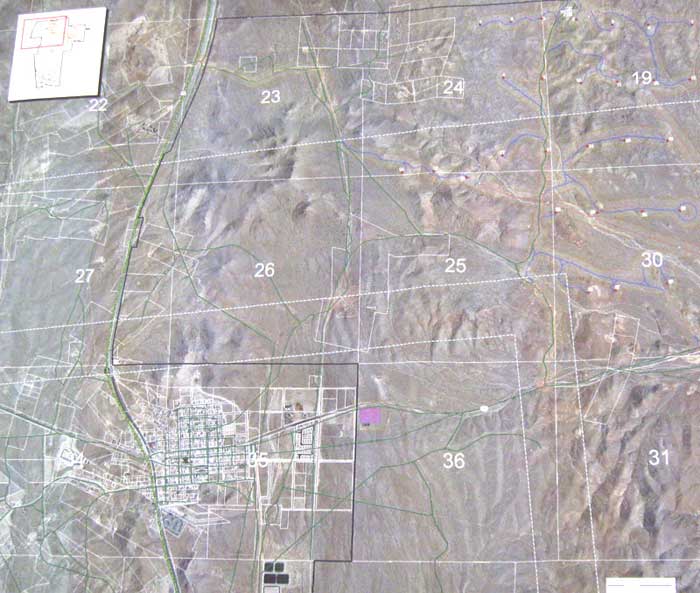
^Northwest section of December 2009 map. The town is shown here on the lower left, while to the right are dark and white dots in the hills representing individual 400-foot wind turbines, connected by new roads in blue.
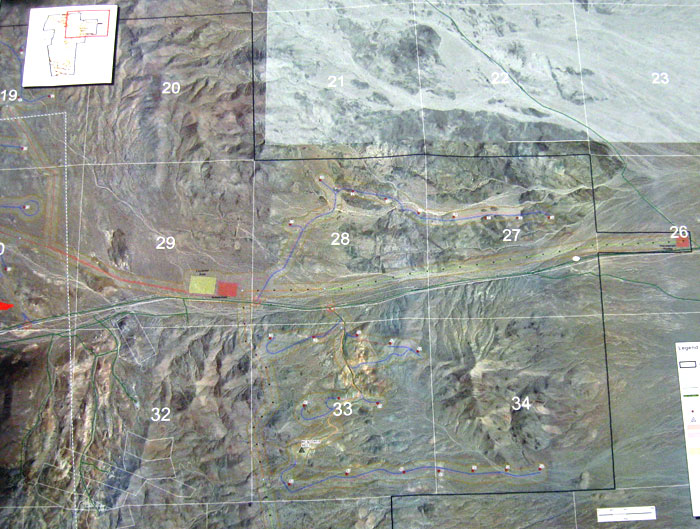
^Northeast section of map. Turbines are shown north and south of the road that goes from Highway 95 to Lake Mead (east of this map).
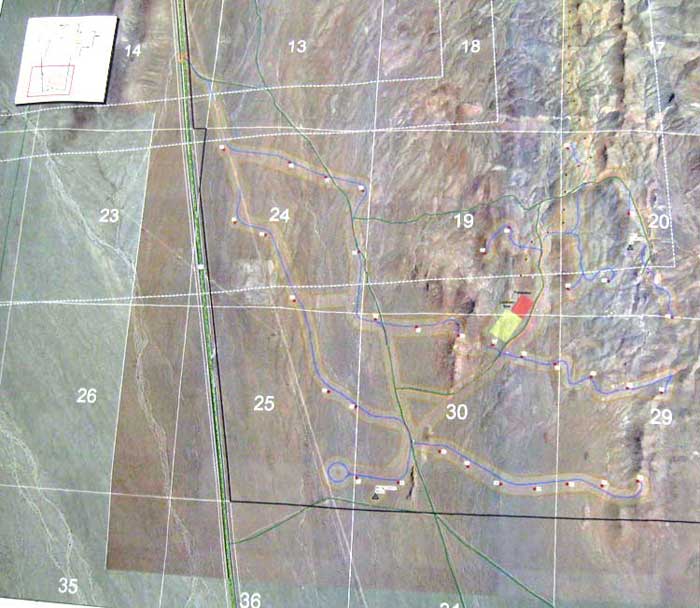
^Southern part of map, showing turbine lay-out just east of Highway 95.
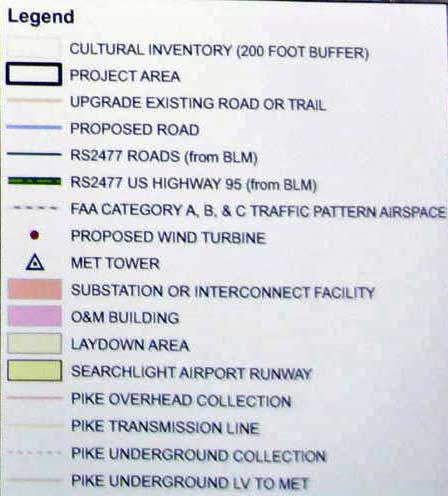
^Key to map. Note the many blue lines on the maps are proposed new roads in Mojave Desert hills where Desert tortoise and Bighorn sheep habitat presently exist.
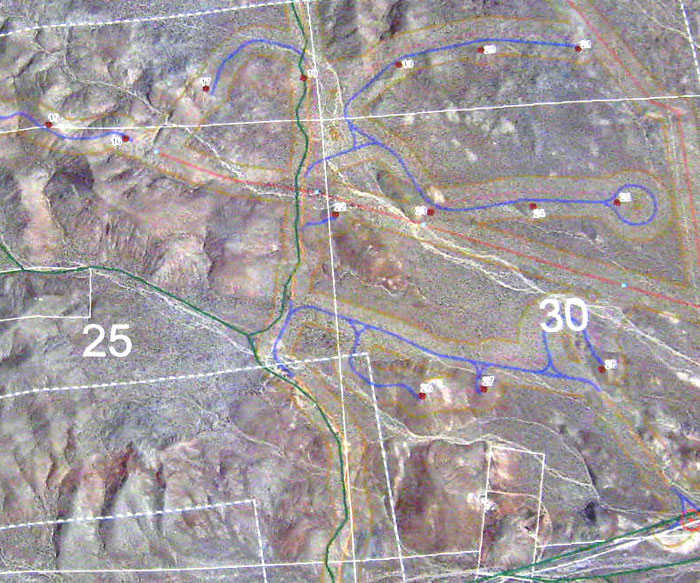
^Enlarged detail of map to show new roads and turbine placement on hills and ridges. Large truck traffic will have to move giant turbine parts into this largely wild area.

^Southern project area that would have wind turbines along Highway 95. Looking east, with Spirit Mountain on the right horizon, an area sacred to many Colorado River Tribes.
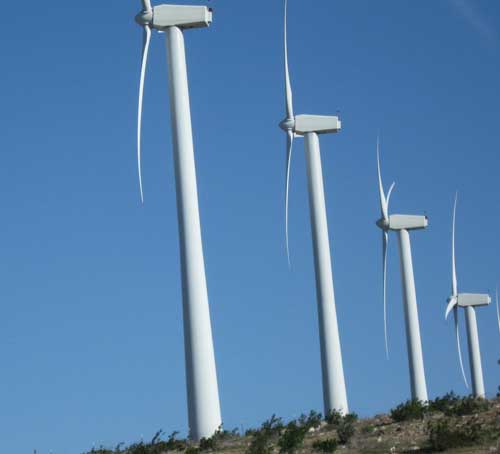
Duke Tries to Influence Town
March 3, 2010 - A Searchlight Community Cleanup will happen Saturday March 13, 2010, sponsored by Duke Energy, according to flyers circulating about town. Duke is proposing to construct a giant wind farm virtually surrounding the town of Searchlight, against the wishes of most local residents.
Searchlight Residents Simulate Their View of the Proposed Wind Farm
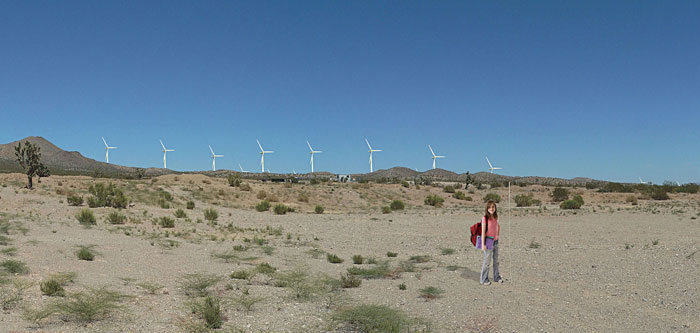
Duke Energy's huge turbine array would be too close to this rural town in southern Nevada, say many long-time residents. Here's their photo-montage of the proposal, looking eastward from town towards the Colorado River Valley below. Recreationists on Lake Mead would have to look up and see this array from the other side.

Joshua trees, beautiful Mojave Desert hills, and houses views would be marred by industrialization in this potential vista. Low humming and subsonic vibrations would emanate from these turbines, and at night flashing aviation-warning lights would shine on residences.
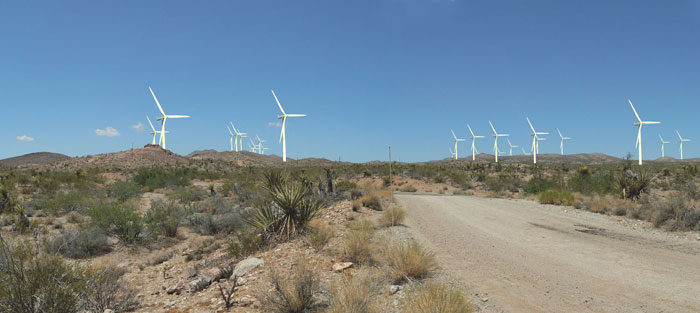
^ This simulation is on the road to Cottonwood, about 3 miles from Searchlight. From the Nugget, it should be about 3 1/4 miles. The tower height represented in the pictures is
80 meters and the blades are 49 meters, 262 feet and 161 feet respectively.
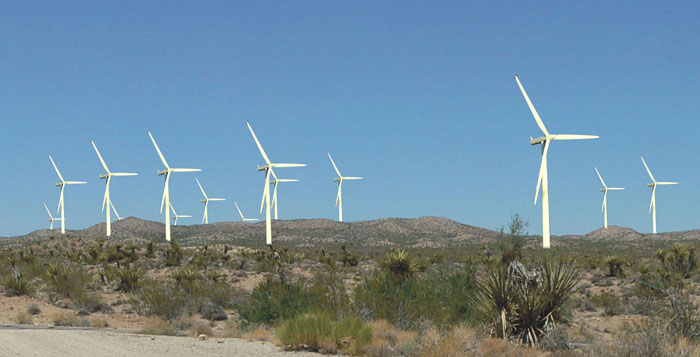
^Detail of the simulation photo, above. This area is a popular recreation site -- but our desert would be industrialized by a corporation (Duke Energy) from the eastern U.S.
^View of the town of Searchlight, Nevada, looking eastward from near the Castle Mountains at the edge of Mojave National Preserve in California. Most of the hills on the horizon would be covered with lines of tall wind turbines similar to those discussed below. The remote vistas would change in this region.
Draft EIS Schedule
October 7, 2009 -
The Draft Environmental Impact Statement for the Searchlight Wind Project, according to a communication we had with Bureau of Land Management in Las Vegas, would be due out in June 2010. This estimated date has changed, and may change again.
An environmental impact statement (EIS) is a document required by the National Environmental Policy Act (NEPA) for federal government agency actions significantly affecting the quality of the environment. A tool for decision making, an EIS describes the positive and negative environmental effects of proposed agency action, and cites alternatives. After public scoping comments are collected, a Draft EIS with a full description of the affected environment, a reasonable range of alternatives, and an analysis of the impacts of each alternative is issued. The public is then provided a second opportunity to provide comments.
The Final EIS is based on the comments to the Draft EIS and expertise collected. In this the agency announces its Proposed Action. The public is not invited to comment on this, but if they are still unhappy, or feel that the agency has missed a major issue, they may protest the EIS to the Director of the agency. The Director may either ask the agency to revise the EIS, or explain to the protester why their complaints are not addressed.
A Record of Decision (ROD) is the final action issued by the agency. This will decide if, in this case, Duke Energy will be given a right-of-way permit (ROW) to build and operate its wind project. If members of the public are still dissatisfied with the outcome they have the right to sue the agency in Federal court.
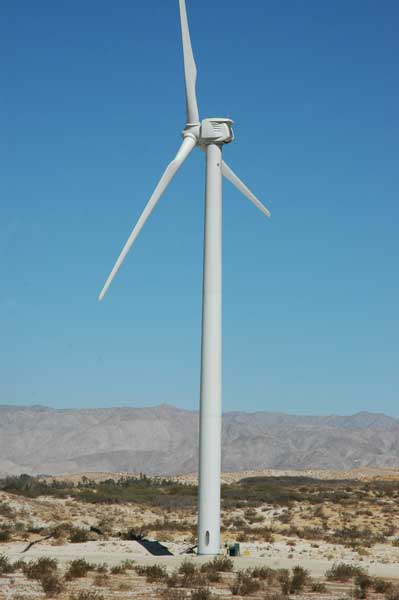
Giant Wind Turbines: A Visit to Palm Springs
October 1, 2009 -
We recently visited the Edom Hills Wind Energy Project near Palm Springs, California, where tall turbines dot the hills. They are similar in size to those that would line the ridges above Searchlight, Nevada.
These things are huge, dwarfing the numerous smaller turbines that form much of the Palm Springs wind farm closer to San Gorgonio Pass.
BP recently bought and upgraded the project, replacing 139 wind turbines which were 20 years old, with eight Clipper Liberty 2.5 megawatt (MW) turbines, increasing the power to 20 MW (source: BP).
At Searchlight, Duke Energy would use Siemens 2.3 MW or similar turbines, each with a 240-foot steel tubular tower supporting a three-blade rotor 279 feet in diameter. Each blade is 140 feet long.
These turbines operate at maximum power output when the wind blows at 33 mph. At winds over 55 mph they automatically shut down to limit stress on the machinery.
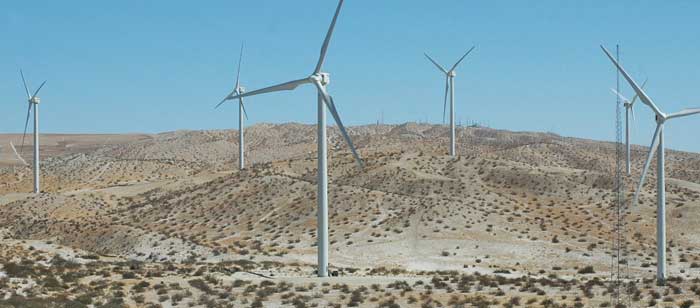
^Edom Hills wind turbines. The day we walked around the area the rotors were turning in a breeze, making a low rhythmic humming noise. A meteorological tower stands to the right.
Duke originally wanted 156 such monsters surrounding the town of Searchlight, but the numbers have dropped due to various conflicts with private lands and the local airport.
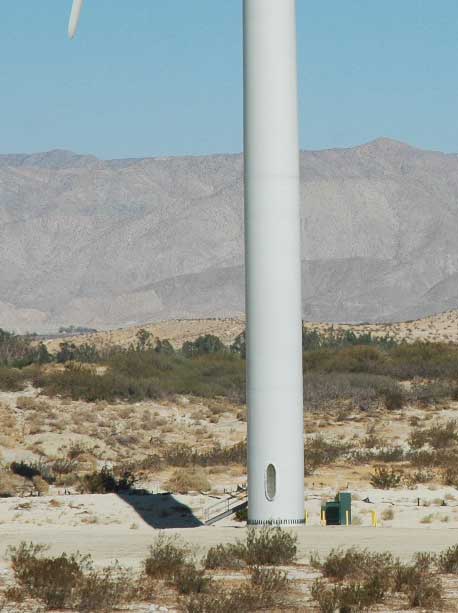 A permanently cleared area with no vegetation can be seen around the base of each turbine, as in the photo to the right. Notice the size of the small entry ladder into the base of the tower.
A permanently cleared area with no vegetation can be seen around the base of each turbine, as in the photo to the right. Notice the size of the small entry ladder into the base of the tower.
The rare plant Coachella Valley milkvetch (Astragalus lentiginosus var. coachellae) was impacted by the development of this wind project, according to the Coachella Valley Multiple Species Habitat Conservation Plan.
The project was built on land leased from the County of Riverside Waste Management Department, near a landfill. The lease was signed in 2005 and runs for 34 years. An initial payment of $20,000 from the developer to the county plus a one-time payment of $1,500 for each wind turbine installed on the property was agreed upon. A monthly "minimum-rent" payment of $500 per megawatt of installed capacity and a royalty payment of 5% of the gross operating proceeds, in excess of the "minimum rent", followed (source: Riverside County Clerk - http://www.clerkoftheboard.co.riverside.ca.us/agendas/2005/2005_03_01/12.01.pdf).
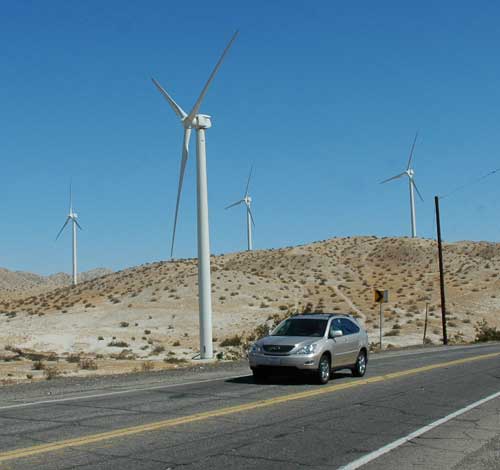
<They tower over cars driving by. The camera does not truly show the height of these turbines, the nearest turbine shown here being over 1,000 feet distant from the road.
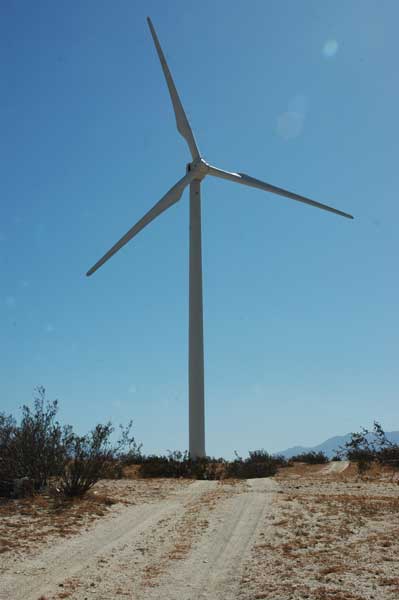
>Dirt roads cut up the hills through creosote desert to access each turbine. Some areas were fenced, other turbines were unfenced.
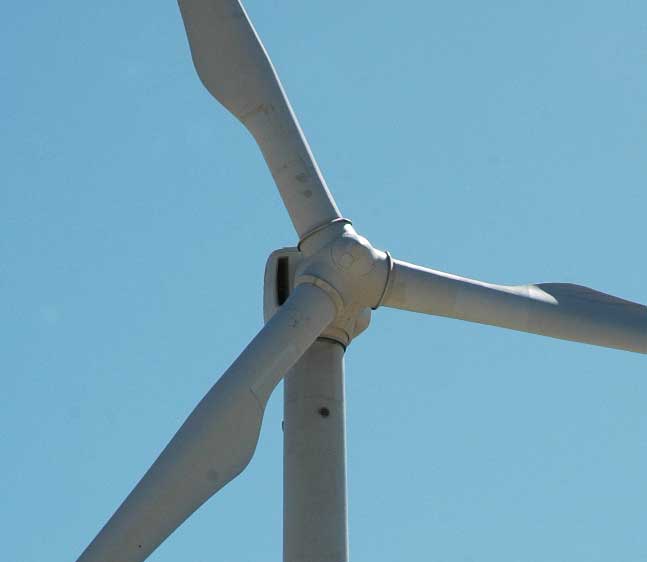
^Blades attached to huge nacelle containing gears to generate electricity. A person can climb into the nacelle for repairs.
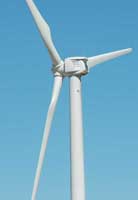 Searchlight Wind Project, Nevada - Updates
Searchlight Wind Project, Nevada - Updates